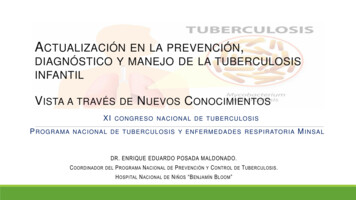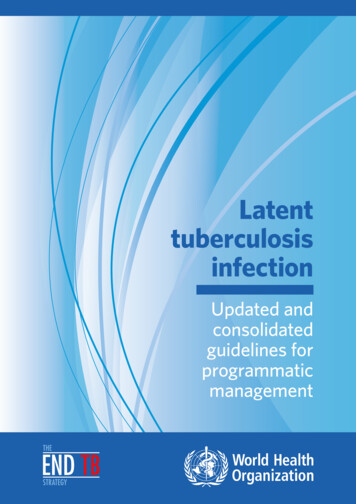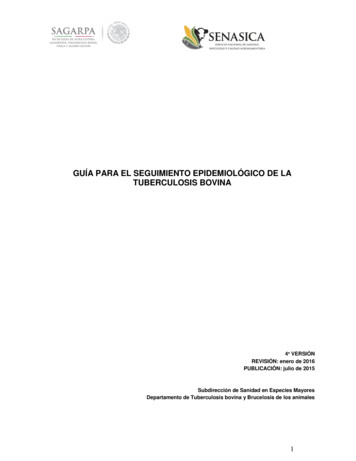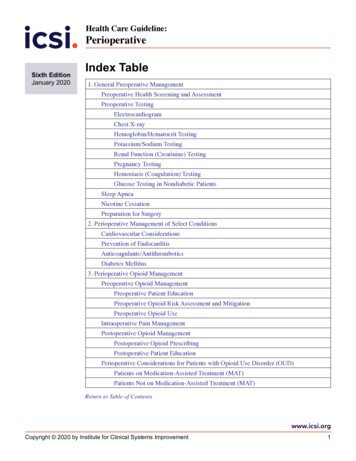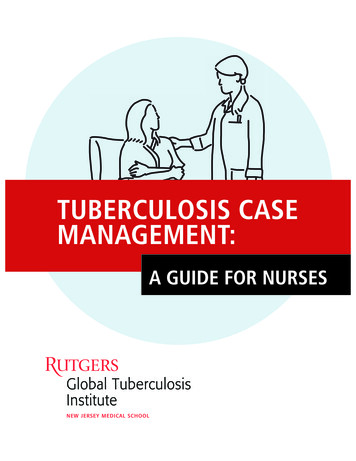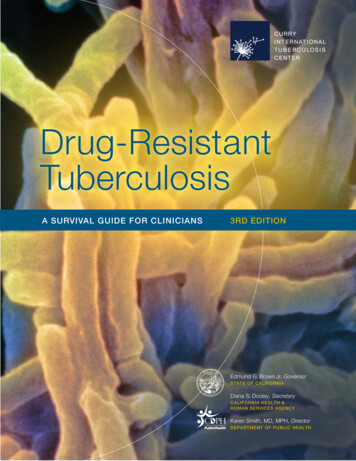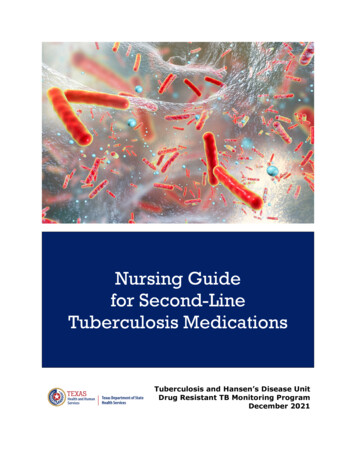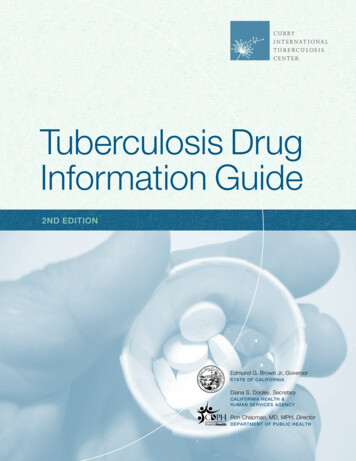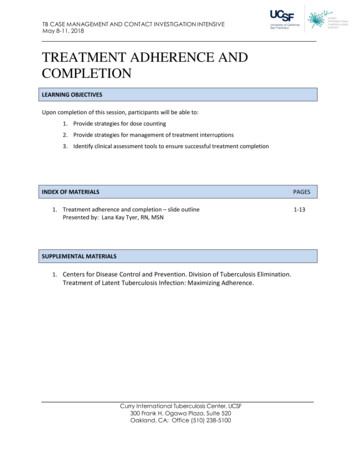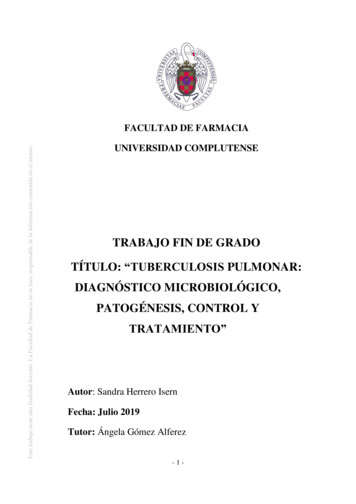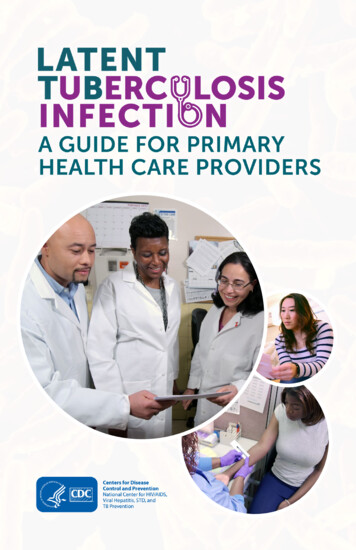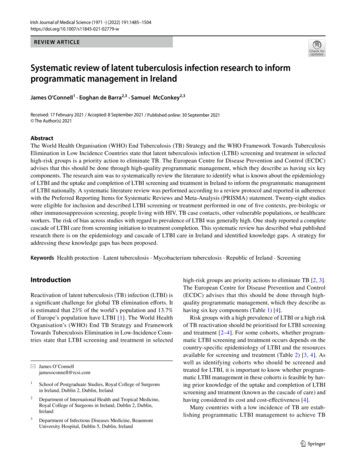
Transcription
Irish Journal of Medical Science (1971 -) (2022) 02779-wREVIEW ARTICLESystematic review of latent tuberculosis infection research to informprogrammatic management in IrelandJames O’Connell1 · Eoghan de Barra2,3 · Samuel McConkey2,3Received: 17 February 2021 / Accepted: 8 September 2021 / Published online: 30 September 2021 The Author(s) 2021AbstractThe World Health Organisation (WHO) End Tuberculosis (TB) Strategy and the WHO Framework Towards TuberculosisElimination in Low Incidence Countries state that latent tuberculosis infection (LTBI) screening and treatment in selectedhigh-risk groups is a priority action to eliminate TB. The European Centre for Disease Prevention and Control (ECDC)advises that this should be done through high-quality programmatic management, which they describe as having six keycomponents. The research aim was to systematically review the literature to identify what is known about the epidemiologyof LTBI and the uptake and completion of LTBI screening and treatment in Ireland to inform the programmatic managementof LTBI nationally. A systematic literature review was performed according to a review protocol and reported in adherencewith the Preferred Reporting Items for Systematic Reviews and Meta-Analysis (PRISMA) statement. Twenty-eight studieswere eligible for inclusion and described LTBI screening or treatment performed in one of five contexts, pre-biologic orother immunosuppression screening, people living with HIV, TB case contacts, other vulnerable populations, or healthcareworkers. The risk of bias across studies with regard to prevalence of LTBI was generally high. One study reported a completecascade of LTBI care from screening initiation to treatment completion. This systematic review has described what publishedresearch there is on the epidemiology and cascade of LTBI care in Ireland and identified knowledge gaps. A strategy foraddressing these knowledge gaps has been proposed.Keywords Health protection · Latent tuberculosis · Mycobacterium tuberculosis · Republic of Ireland · ScreeningIntroductionReactivation of latent tuberculosis (TB) infection (LTBI) isa significant challenge for global TB elimination efforts. Itis estimated that 23% of the world’s population and 13.7%of Europe’s population have LTBI [1]. The World HealthOrganisation’s (WHO) End TB Strategy and FrameworkTowards Tuberculosis Elimination in Low-Incidence Countries state that LTBI screening and treatment in selected* James O’Connelljamesoconnell@rcsi.com1School of Postgraduate Studies, Royal College of Surgeonsin Ireland, Dublin 2, Dublin, Ireland2Department of International Health and Tropical Medicine,Royal College of Surgeons in Ireland, Dublin 2, Dublin,Ireland3Department of Infectious Diseases Medicine, BeaumontUniversity Hospital, Dublin 5, Dublin, Irelandhigh-risk groups are priority actions to eliminate TB [2, 3].The European Centre for Disease Prevention and Control(ECDC) advises that this should be done through highquality programmatic management, which they describe ashaving six key components (Table 1) [4].Risk groups with a high prevalence of LTBI or a high riskof TB reactivation should be prioritised for LTBI screeningand treatment [2–4]. For some cohorts, whether programmatic LTBI screening and treatment occurs depends on thecountry-specific epidemiology of LTBI and the resourcesavailable for screening and treatment (Table 2) [3, 4]. Aswell as identifying cohorts who should be screened andtreated for LTBI, it is important to know whether programmatic LTBI management in these cohorts is feasible by having prior knowledge of the uptake and completion of LTBIscreening and treatment (known as the cascade of care) andhaving considered its cost and cost-effectiveness [4].Many countries with a low incidence of TB are establishing programmatic LTBI management to achieve TB13Vol.:(0123456789)
1486Irish Journal of Medical Science (1971 -) (2022) 191:1485–1504Table 1 Key components for the programmatic management of latent tuberculosis infectionComponent123456Identification of groups at risk of having LTBI or an increased risk of progressing to active TB. These target groups should be prioritizedfor LTBI screening and treatmentDefinition of diagnostic approach for LTBI detection, including both the selection of diagnostic test(s) and the diagnostic algorithm mostappropriate for each target groupProvision of LTBI treatment using treatment regimens that are effective and promote adherence and completion by different target groupsImplementation of patient-centred strategies for service deliveryEffective health education and communication with target groups and health care providersProgramme monitoring and evaluationLTBI latent tuberculosis infectionelimination after researching the prevalence of LTBI indifferent cohorts and the feasibility of programmatic LTBImanagement. In the United Kingdom (UK), they haveidentified that immigrants from countries with a very highincidence of TB contribute significantly to the case burdennationally [5, 6]. They have demonstrated a high prevalenceof LTBI among these immigrant cohorts and demonstratedthat the rate of TB reactivation over time was significant,suggesting that TB reactivation, as opposed to primary TBinfection, explained the high TB incidence in this cohort[7, 8]. Furthermore, they have researched the feasibility,acceptability and cost effectiveness of different screeningstrategies among high-risk immigrant cohorts [9–12]. Public Health England has established a national LTBI testingand treatment program for immigrants from countries witha high incidence of TB informed by their research on theprevalence of LTBI and feasibility of programmatic screening in this cohort [13]. This was a key action of their nationalcollaborative strategy for TB [14]. Evidently, LTBI epidemiological and cascade of care research informed and enabled Public Health England to establish programmatic LTBImanagement in a target risk cohort.The aim of this systematic review was to identify whatis known about the epidemiology and cascade of care ofLTBI in Ireland to inform its programmatic managementnationally.MethodsA systematic literature review was performed according to areview protocol and reported in adherence with the PreferredReporting Items for Systematic Reviews and Meta-Analysis(PRISMA) statement (Appendix 1) [15]. The protocol forthis systematic review was registered with the Open ScienceFramework (https://d oi.o rg/1 0.1 7605/O SF.I O/8 ED29) and isavailable in Appendix 2.Studies eligible for inclusion were those that describedany group of patients who were screened or treated forLTBI in Ireland and reported using any one or a combination of chest radiography, tuberculin skin resting (TST) orinterferon-gamma release assay (IGRA) testing to screenfor LTBI. Studies had to report at least one of the following outcomes (chosen because they describe the cascade ofLTBI care): the proportion of people screened out of thetarget population, the prevalence of a positive screening testin the target population, the proportion of those diagnosedwith LTBI who were offered treatment, the proportion ofTable 2 Programmatic screening and treatment of latent tuberculosis infection in countries with a low incidence of TB [3, 4]Cohorts which should be programmatically screened and treated in all EU/EEA countriesCohorts where programmatic screening and treatment is dependenton the country specific LTBI epidemiology and resources availableImmunosuppressed persons (such as patients on anti-TNF alpha treatment),People living with HIV (regardless of CD4 cell count or HIV antiretroviraltherapy status)Patients preparing for transplantationPatients with end-stage renal diseases and/or preparing for dialysisPatients with silicosis; people with pulmonary fibrotic lesionsContacts of infectious TB cases (based on a risk assessment of their exposure)People who are homelessPeople who use drugsPrison inmatesImmigrants from countries with a high TB incidenceHealth care workersEU European Union, EEA European Economic Area, TNF tumour necrosis factor, Area: CD4 cluster of differentiation 4, LTBI latent tuberculosis infection13
Irish Journal of Medical Science (1971 -) (2022) 191:1485–1504those diagnosed with LTBI who started treatment for LTBI,the proportion of those diagnosed with LTBI who completedtreatment out and the cost of performing screening or treatment of LTBI cases identified.Clinical audits, randomized controlled trials, diagnosticaccuracy studies, retrospective cohort reviews and prospective cohort reviews published between the 1st of January2000 and the 31st of December 2019 (inclusive) were eligible for inclusion. Studies published in languages other thanEnglish were not eligible for inclusion. Studies where it wasnot possible to extract data on patients screened in Irelandalone were excluded.A search of MEDLINE (via OVID), Embase, Web ofScience, Google Scholar and published abstracts fromnational conferences in Ireland was conducted (search strategy is described in Appendix 2, date of last search: 14th ofMay 2020). The references of included studies were alsosearched. The literature search and data extraction wereeach conducted independently by two reviewers, and anydisagreements relating to study eligibility or data extractionwere resolved by discussion and mutual agreement. For theprevalence of a positive screening test, the risk of bias wasassessed using a tool designed for TB prevalence studies thatwas derived from on an existing tool for prevalence studies(Appendix 3) [16].1487Characteristics of included studiesThe included studies described LTBI screening or treatmentperformed in one of five contexts (Table 3), pre-biologicor other immunosuppressive treatment screening (11 studies [17–27]), people living with human immunodeficiencyvirus (PLWHIV) (two studies [28, 29]), TB case contactsor prior to Bacillus Calmette–Guérin (BCG) vaccination(nine studies [30–38]), other vulnerable populations (twostudies in asylum seekers [39, 40]) or health care workers(five studies [29, 41–44]). Most studies (19/28) were retrospective cohort reviews, seven were prospective cohortreviews and for one study, the design was unclear. All studies were performed on a regional or local level. Fourteenof 28 studies were conducted in tertiary care centres, ninewere conducted in public health departments, and threewere in secondary care centres.The reporting of the cascade of care was generally veryincomplete (Table 4). Only six studies described the proportion of the target population that completed screening.Provider recommendation, patient acceptance and patientcompletion of LTBI treatment were reported in 10, 12 andeight studies, respectively. One of 28 studies reported thecomplete cascade of care from screening initiation to treatment completion [17]. One study reported an estimate of thecost of LTBI screening and treatment [26].ResultsRisk of bias assessmentSearch resultsThe results of the search are described in Fig. 1. Fifty-twoarticles were identified for full-text review from the search ofthe indexed literature, Google Scholar, conference abstractsearches, and the references of included articles. In total,28 studies were identified as meeting the review inclusioncriteria.Records returned fromRecords returned fromRecords returned fromGoogle Scholar Search n 11Embase searchMEDLINE searchWeb of Science searchConference abstracts search n 11n 44n 89n 198Searching references of includedarticles n 1Titles and abstracts identified forscreeningn 354Records excluded (n 283)Did not relate to the Republic of Ireland (n 64)Related to active TB disease (n 25)Did not related to humans (n 81)Described non-TB disease (n 42)Outside of review reference period (n 21)Pre-clinical studies (n 25)Other (n 25)Duplicate records excluded (n 18)Titles and abstracts screenedafter duplicates removedn 336Full-text articles assessed foreligibilityn 52Full-text articles included inreviewn 28Fig. 1 Flow diagram of literature searchArticles excluded (n 24)Did not relate to Republic of Ireland (n 8)Did not describe outcome of latent TB screening ormanagement (n 7)Active TB (n 1)Review/perspective article (n 8)The overall risk of bias in assessing the prevalence of LTBIin the included studies was high (Table 5, Appendix 3). Convenience sampling occurred in 25 of 26 studies. In 12 of26 studies, there was a lack of a description of the patientexclusion criteria or how TB disease was identified. In 19 of26 studies, the response rate, or the proportion of the targetpopulation who were screened, was not reported. Overall,the risk of bias was low (score 6–8) in two studies, moderate (score 3–5) in seven studies and high (score 0–2) in 17studies.In the 11 studies evaluating LTBI screening in immunosuppressed patients, the risk of bias was high in six of 11 studies,moderate in four of 11 studies and low in one of 11 studies.In the two studies evaluating LTBI screening in people livingwith HIV, the risk of bias was high in one study and moderatein the other. In the eight studies evaluating LTBI screening inrecent TB contacts, the risk was high in six of eight studies,moderate in one of eight studies and low in one of eight studies. In the two studies evaluating LTBI screening in asylumseekers, the risk of bias was moderate in one study and low inthe other. All four studies which evaluated LTBI screening inhealth care workers had a high risk of bias. Aside from the riskof bias within studies, there is a risk of reporting bias across13
1488Irish Journal of Medical Science (1971 -) (2022) 191:1485–1504Table 3 Characteristics of studies includedStudyStudy design* SettingCohort (cohort size)Gnanasekaran et al. [17]O’Flynn et al. [18]Awan et al. [19]O’Flynn et al. [20]Hurley et al. [21]Safwat et al. [22]Haroon et al. [23]O’Flynn [24]Martin et al. [25]Jordan et al. [26]Kelly et al. [27]Ní Cheallaigh et al. [28]Ali et al. pectiveSecondary centreTertiary centreSecondary centreTertiary centreTertiary centreSecondary centreTertiary centreTertiary centreTertiary centreTertiary centreTertiary centreTertiary centreTertiary centreHiggins et al. [30]Glynn et al. [31]O’Donovan et al. [32]O’Meara et al. [33]O’Sullivan et al. [34]Bambury et al. [35]Gaensbaeur et al. [36]Hennessy [37]Tam et al. [38]Millar et al. HDTertiary centrePHDDoyle et al. [40]RetrospectivePHDSmyth et al. [41]Kelly et al. [42]Power et al. [43]Arya et al. ectiveUnknownTertiary centreTertiary centreTertiary centrePre-biologic screening in patients with IA (n 39)Pre-biologic screening in patients with IA (n 70)Pre-biologic screening in patients with IA (n 25)Pre-biologic screening in patients with IA (n 109)Pre-organ transplantation screening (n 101)Pre-biologic screening (43% of cohort) (n 78)Pre-biologic screening in patients with IA (n 132)Pre-biologic screening in patients with IA (n 188)Pre-biologic screening in patients with IA (n 150)Pre-biologic screening in patients with IA (n 63)Pre-biologic screening in patients with psoriasis (n 101)People living with HIV (n 256)PLWHIV (n 331), Occupational screening of new entrant health careworkers (n 2410)TB outbreak (6 cases) in the community (n 268)Contact tracing of 39 sporadic TB cases (n 701)TB outbreak (6 cases) in university students (n 71)TB outbreak (3 cases) in a primary school (n 307)TB outbreak (13 cases) in a secondary school (n 1200)Contact tracing of 118 sporadic TB cases (n 1082)TB outbreak in two creches (n 268)Children tuberculin skin tested before BCG (1854)TB-related referrals to a specialist paediatric clinic (n 13)Asylum seekers attending communicable disease screening in Cork andKerry (n 4780)Asylum seekers undergoing communicable disease screening 1998–2003(n 236)Health care workers with significant exposure to infectious TB (n 41)Occupational screening of overseas health care workers (n 505)Overseas nursing recruits from India (n 54)Health care workers with a positive TST referred to the TB clinic (n 243)IA inflammatory arthritis, PHD Public Health Department, PLWHIV people living with HIV*All studies were cohort reviewsstudies. Studies where any one or more of the offering, uptakeand completion of screening or treatment for LTBI was poormay not have reported these outcomes.Latent TB infection screening and treatmentoutcomes in patients undergoingimmunosuppressionGnanasekaran et al. [17] was the only study that reportedthe proportion of the target population screened (95% of thetarget cohort) (Table 6). The median prevalence of a positiveIGRA across all studies in this cohort was 7% (interquartile range (IQR) 7–8%). When considering only the studieswhere the risk of bias was moderate-low, the prevalence of apositive IGRA was 7% (IQR 5–7%). The median prevalence13of a positive TST across all studies in this cohort was 17%(13–26%) and when considering only studies where the riskof bias was moderate-low, the median prevalence of a positive TST was 17% (IQR 15–18%).In all seven studies where the proportion of patients whowere offered and accepted LTBI treatment was reported[17–20, 26, 27, 46], all patients were offered and acceptedtreatment. The median proportion of patients completingtreatment was 100% (IQR 90–100%), with all patients inthree studies [17, 19, 26] completing treatment, and 61%of patients in one study [23] completing treatment. Jordanet al. [26] reported the cost of treating four patients withLTBI diagnosed using an IGRA as 1652 and 21 patientsdiagnosed using a TST as 6174, although the methodologyused to make these cost estimates is unclear.
Irish Journal of Medical Science (1971 -) (2022) 191:1485–15041489Table 4 Screening tests and outcomes reported in included literatureStudyScreening test(s)reportedOutcome(s) rophylaxisStudies evaluating latent TB infection screening in immunosuppressed patientsGnanasekaran et al.IGRA, CXRYesYesYesYes[17]O’Flynn et al. [18]UnclearNoYesNoNoAwan et al. [19]IGRA, TSTNoYesYesYesNoYesO’Flynn et al. [20]IGRA YesYesHurley et al. [21]IGRA, TSTNoYesNoNoSafwat et al. [22]IGRA, TST, CXRNoYesNoNoHaroon et al. [23]TST, CXRNoYesYesYesO’Flynn 2012 [24]IGRA, TST, CXRNoYesYesYesMartin et al. [25]IGRA, CXRNoYesNoNoJordan et al. [26]IGRA, TST, CXRNoYesYesYesKelly et al. [27]IGRA, TST, CXRNoYesYesYesProportion of studies reporting outcome1/1111/117/117/11Studies evaluating latent TB infection screening in people living with HIVIGRA, TSTNoYesYesNoNí Cheallaigh et al.[28]Ali et al. [29]TST, CXRNoYesNoNoProportion of studies reporting outcome0/22/21/20/2Studies evaluating latent TB infection screening in recent TB contacts or prior to BCG vaccinationHiggins et al. [30]TSTYesYesNoYesGlynn et al. [31]UnclearYesYesNoYesO’Donovan et al. [32] UnclearNoYesNoNoO’Meara et al. [33]TST, CXRYesYesNoNoO’Sullivan et al. [34] TST, CXRNoYesNoNoBambury et al. [35]UnclearYesYesNoNoGaensbaeur et al. [36] TST, CXRYesYesNoNoHennessy [37]TST, CXRNoYesNoNoTam et al. [38]TST, CXRNoNoYesNoProportion of studies reporting outcome5/98/91/92/9Studies evaluating latent TB infection screening in asylum seekersMillar et al. [39]UnclearNoYesNoNoDoyle et al. [40]TST, CXRNoYesNoYesProportion of studies reporting outcome0/22/20/2½Studies evaluating latent TB infection screening in health care workersAli et al. [29]TST, CXRNoYesNoNoSmyth et al. [41]TSTNoYesNoNoKelly et al. [42]IGRA, TSTNoYesYesYesPower et al. [43]TST, CXRNoYesNoNoArya et al. [44]TST, CXRNoNoNoYesProportion of studies reporting outcome0/54/51/52/5Proportion of all studies reporting hylaxisCost NoNoYesNoYes2/58/28NoNoNoNoNo0/51/28TST tuberculin skin test, IGRA interferon gamma release assay, CXR chest radiography13
1490Irish Journal of Medical Science (1971 -) (2022) 191:1485–1504Table 5 Risk of bias assessmentStudyStudies evaluating latent TB infection screening in patients undergoing immunosuppressionGnanasekaran et al. [17]O’Flynn et al. [18]Awan et al. [19]O’Flynn et al. [20]Hurley et al. [21]Safwat et al. [22]Haroon et al. [23]O’Flynn [45]Martin et al. [25]Jordan et al. [26]Kelly et al. [27]Studies evaluating latent TB infection screening in people living with HIVNi Cheallaigh et al. [28]Ali et al. [29]Studies evaluating latent TB infection screening in recent TB contacts or prior to BCG vaccinationHiggins et al. [30]Glynn et al. [31]O’Donovan et al. [32]O’Meara et al. [33]O’Sullivan et al. [34]Bambury et al. [35]Gaensbaeur et al. [36]Hennessy [37]Tam et al. [38]Studies evaluating latent TB infection screening in vulnerable population groupsMillar et al. [39]Doyle et al. [40]Studies evaluating latent TB infection screening in health care workersAli et al. [29]Smyth et al. [41]Kelly et al. [42]Power et al. [43]Arya et al. [44]Total risk of biasscoreRisk of e2120N/aHighHighHighHighN/aN/a not applicableThese studies did report on the outcome of LTBI screening, including the prevalence of a positive screening test among the screened population.Therefore, they could not be assessed using the selected risk of bias toolLatent TB infection screening and treatmentoutcomes in people living with HIVNi Cheallaigh et al. [28] reported the proportion of people living with HIV who had a positive test when screenedusing an IGRA as 18% when T-SPOT was used and 11%when QuantiFERON was used (sample sizes 256 and 247,respectively). When a TST was used among PLWHIV, the13proportion of patients diagnosed with LTBI was 10% inthe study by Ni Cheallaigh et al. [28] and 11% in the studyby Ali et al. [29] (sample sizes 93 and 331 respectively).However, the risk of bias in the study by Ali et al. [29] washigh. Ni Cheallaigh et al. [28] reported that all patients whowere diagnosed with LTBI were offered treatment. No studyreported on the proportion of patients completing LTBItreatment in this cohort.
Irish Journal of Medical Science (1971 -) (2022) 191:1485–15041491Table 6 Results of studies evaluating LTBI in immunosuppressed patientsStudyRiskof biasscoreRisk of bias moderate-lowGnanasekar-an 7et al. [17]Haroon et al.4[23]O’Flynn [46]*4Proportion with aTarget samplesize/proportion positive screeningof target sample sCost of screening/treatment37/39(95%)132IGRA 2/37 (5%)TST 23/132 (17%)TST 22/165 (13%)IGRA 11/161 (7%)TST 27/150 (18%)IGRA(T-SPOT) 14/143(10%)IGRA (QFT) 5/70 (7%)IGRA 5/71 RNRNRNR5/55/5NRNRUnknown test 11/70(16%)TST 3/25(12%)IGRA 2/25(8%)IGRA 9/109 (8%)TST 9/101 (9%)IGRA 8/101 (8%)TST 17/41 (41%)IGRA 12/78 (15%)TST 21/63 (33%)IGRA 4/63 2/2222/2222/22Cost of LTBI management4 IGRA 1,65218 TST 6,174188Martin et al.[25]4150Kelly et al. [27]4101Risk of bias high0O’Flynn et al.[18]Awan et al. [19] 07025O’Flynn et al.[20]Hurley et al.[21]21091101Safwat et al.[22]178Jordan et al.[26]063NRTST tuberculin skin test; IGRA interferon gamma release assay; QFT quantiFERON; NR not reported*TST performed first, IGRA then performed if TST negativeLatent TB infection screening and treatmentoutcomes in recent TB contacts or prior to BCGvaccinationThree studies reported on the proportion of the target samplescreened as part of contact tracing with 97%, 83% and 79%respectively being screened (Table 7) [30, 31, 33, 35]. Sevenstudies reported on the proportion of patients diagnosed withLTBI in this cohort [30–36]. There were only two studieswhere the risk of bias was moderate-low and the screeningtest used was reported in the context of TB contact tracing.The study by O’Meara et al. described a TB outbreak in aprimary school setting with 191 children screened using aTST [33]. Gaensbaeur et al. reported on two TB outbreaksin creches where 268 children were screened [36]. Theprevalence of a positive TST in these studies was 9% and13
1492Irish Journal of Medical Science (1971 -) (2022) 191:1485–1504Table 7 Results of studies evaluating latent TB screening in recent TB contacts or prior to BCG vaccinationStudyRiskof biasscoreRisk of bias moderate-lowO’Meara et al. [33] 6Gaensbaeur et al.4[36]Risk of bias highHiggins et al. [30]2Glynn et al. [31]0Target sample size/proportion of targetsample screenedProportion screened t ofscreening/treatment244/307 (79%)268TST 17/191 (9%)TST 20/268 (7%)NRNRNRNRNRNRNRNR260/268 (97%)585/701 (83%)TST 48/260 (19%)Unknown test76/585 (13%)Unknown test 26/71(37%)TST 60/1200( 5%)Unknown 223/1082(21%)TST 13/1854( 1%)NRNR46/76 (71%)15/48 (31%)NRNR15/46 (33%)NRNRNRNRNRNRNRNRNRNRNR150/223 (67%)116/150 (77%)NRNRNRNRNR13/13 (100%)NR10/13 (77%)NRO’Donovan et al.[32]O’Sullivan et al.[34]Bambury et al. [35]0710120001082Hennessy [37]1NRTam et al. [38]N/aNRN/a Not applicable, NR Not reported, TST tuberculin skin test7% respectively. One study reported on the proportion ofrecent TB contacts diagnosed with LTBI who were offeredtreatment, 61% [31]. Two studies reported on the proportionof TB case contacts accepting treatment as 31% and 67%[30, 35]. Two studies reported on the proportion of patientscompleting treatment as 33% and 77% [30, 35]. Two studies described the outcome of LTBI screening prior to BCGvaccination, one of which reported 13 cases of LTBI beingoffered treatment, 10 of whom accepted and completed treatment [38].Latent TB infection screening and treatmentoutcomes in asylum seekersMillar et al. [39] reported on the proportion of the targetsample screened in asylum seekers (28%) where screeningwas voluntary. Doyle et al. [40] reported that of 334 TSTsplaced in a cohort of asylum seekers, only 236 were read. Inthis study, when screened using TST, 5/236 (2%) of thoseread were positive. Of these five patients, three were startedon treatment. It is unclear if the remaining patients were notoffered or declined LTBI treatment, and it is unclear howmany completed treatment.Latent TB infection screening and treatmentoutcomes in health care workersFive studies reported on LTBI screening in this cohort(Table 8) [29, 42–44, 46]. Two studies reported on the prevalence of LTBI in health care workers screened using a TST13[29, 46]. In a cohort of new entrant health care workers,32% had LTBI [29] while in health care workers with significant exposure to infectious TB, the prevalence was 56%[46]. Kelly et al. [42] reported that of new entrant healthcare workers from overseas were screened using a TST oran IGRA, 17% had a positive test result of which 85% wereoffered LTBI treatment [43]. Only 26% accepted treatment,all of whom completed treatment. Arya et al. [44] reportedof 243 health care workers with a positive TST referred to aTB clinic, only 59% accepted LTBI treatment, but it is notreported how many were offered LTBI treatment. Of these,62% completed treatment [44].DiscussionThis research presents a comprehensive review of studiesdescribing LTBI prevalence and screening and treatmentoutcomes in Ireland and highlights the significant knowledgegaps. The findings demonstrate that there are few studies thatare reliably informative as to the prevalence of LTBI acrossall risk cohorts in Ireland. Studies were all performed on alocal or regional level. When considering only the studieswhere the risk of bias was moderate-low, the prevalence ofa positive IGRA among immunosuppressed patients was 7%(IQR 5–7%). There is no published research describing theprevalence of LTBI in people from countries with a highincidence of TB, people who are homeless, people in prisons and people who use intravenous drugs in Ireland, andfor asylum seekers, there were only two studies describing
Irish Journal of Medical Science (1971 -) (2022) 191:1485–15041493Table 8 Results of studies evaluating latent TB infection screening in health care workersStudyRiskof biasscoreTarget sample size/proportion of targetsample screenedProportion screened ptingprophylaxisProportion completingprophylaxisCost ofscreening/treatmentAli et al. [29]22410NRNRNRNRSmyth et al. [41]Kelly et al. RNRPower et al. [43]b054NRNRNRNRArya et al. [44]N/a243TST 765/2410(32%)TST 23/42 (56%)TST/IGRA 87/505(17%)TST 3/54(6%)243NR50/85(59%)31/50 (62%)NRTST tuberculin skin test, IGRA interferon-gamma release assayN/a not applicable, NR not reportedabTST or IGRA Chest x-ray followed by TST (Mantoux) if abnormalthe prevalence of LTBI, both of which had a moderate orhigh risk of bias. Regarding health care workers, only twostudies, both performed in the same centre and both witha high risk of bias, were informative as to the prevalenceof LTBI. Despite these cohorts having an increased risk ofTB in other low-incidence countries [47–49], it is unclearif the incidence of TB in these cohorts in Ireland is highbecause TB cases are not described according to these characteristics in recent national surveillance reports. However,a 2015 report describing risk factors for TB cases notifiedin 2013 rep
miological and cascade of care research informed and ena-bled Public Health England to establish programmatic LTBI management in a target risk cohort. The aim of this systematic review was to identify what is known about the epidemiology and cascade of care of LTBI in Ireland to inform its programmatic management nationally. Methods
